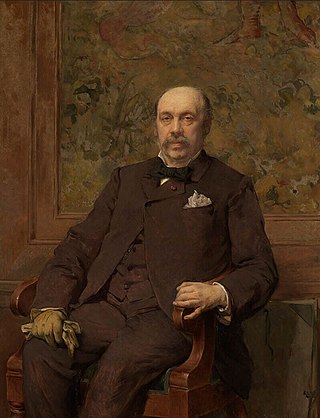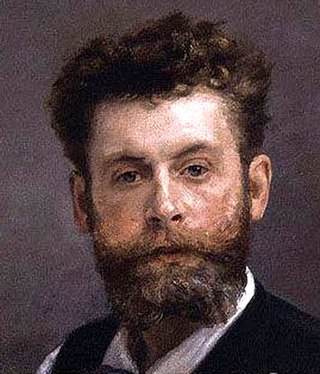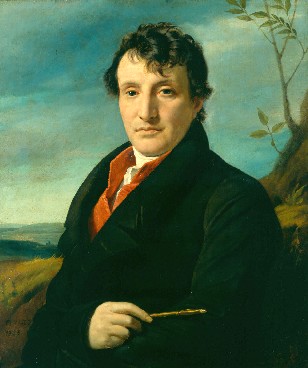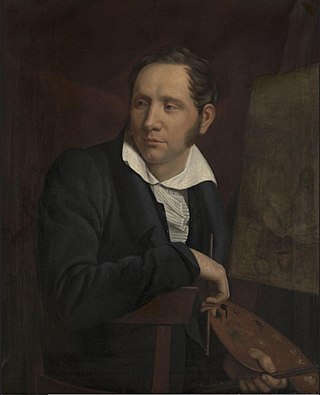Related Research Articles

Jan van Eyck was a painter active in Bruges who was one of the early innovators of what became known as Early Netherlandish painting, and one of the most significant representatives of Early Northern Renaissance art. According to Vasari and other art historians including Ernst Gombrich, he invented oil painting, though most now regard that claim as an oversimplification.

Thomas Phillips was a leading English portrait and subject painter. He painted many of the great men of the day including scientists, artists, writers, poets and explorers.

Hugo van der Goes was one of the most significant and original Flemish painters of the late 15th century. Van der Goes was an important painter of altarpieces as well as portraits. He introduced important innovations in painting through his monumental style, use of a specific colour range and individualistic manner of portraiture. From 1483 onwards, the presence of his masterpiece, the Portinari Triptych, in Florence played a role in the development of realism and the use of colour in Italian Renaissance art.

Jean-François Portaels or Jan Portaels was a Belgian painter of genre scenes, biblical stories, landscapes, portraits and orientalist subjects. He was also a teacher and director of the Academy of Fine Arts of Ghent and the Académie Royale des Beaux-Arts in Brussels. He is regarded as the founder of the Belgian Orientalist school. He was praised in his time as the premier painter of 'everyday elegance and feminine grace'. Through his art, teaching and his leadership of the Académie Royale in Brussels he exerted an important influence on the next generation of Belgian artists, including his pupil Théo van Rysselberghe.

Carl Frederik von Breda was a Swedish painter who studied in and spent much of his career in Britain before becoming painter to the Swedish court. He was born in Stockholm in 1759, and moved to Britain where he was a student of Joshua Reynolds. Breda specialized in painting portraits and was called "the van Dyck of Sweden". He returned to Sweden 1796 where he became professor at the Academy of Arts, a popular portraitist, and a court painter. Breda married at age 22 and his son, Johan Fredrik, was also a painter, who studied under his father. Breda died in Stockholm in 1818.

Alfred Philippe Roll was a French painter.

Henri Van Assche was a Belgian painter; primarily of landscapes. He was especially well-known for his depictions of waterfalls and water mills. Some of his scenes contain animals painted by Balthasar Paul Ommeganck.

Martin van Meytens was a Swedish-Austrian painter who painted members of the Royal Court of Austria such as Marie Antoinette, Maria Theresa of Austria, Francis I, Holy Roman Emperor, the Emperor's family and members of the local aristocracy. His painting style inspired many other painters to paint in a similar format.

Martin Ferdinand Quadal was a Moravian-Austrian painter and engraver. Quadal is a representative of the Austrian school of painting, working all across Europe in England, Italy, Austria, Holland, Germany, France, and Russia.

William Artaud (1763–1823) was an English painter of portraits and biblical subjects.

Michael Neher, the son of Joseph Neher, a citizen and painter of that city, but of a family from Biberach. Michael received a classical education, and was instructed in the rudiments of painting by Mitterer, and in 1813 entered the Academy at Munich. From 1816 to 1818 he studied under Matthias Klotz, and was then employed by Angelo Quaglio in his theatrical work. After having worked for some time as scene-painter at the Court Theatre, he went to Trento, Milan, and Trieste, and painted portraits. In 1819 he was encouraged by Hieronymus Hess, at Rome, to devote himself to genre painting. On his return to Munich in 1823 he became Conservator of the Art Union. In 1839 he painted several saloons in the Hohenschwangen Schloss, after sketches of Schwind, Gasner, and Schwanthaler. He, however, in 1837 devoted himself entirely to architectural painting, and travelled for improvement on the Rhine, and in Belgium. He was received an honorary member of the Academy at Munich in 1876, and died there in the same year.
John Stanton Ward CBE was an English portrait artist, landscape painter and illustrator. His subjects included British royalty and celebrities.

Constant Montald was a Belgian painter, muralist, sculptor, and teacher.

Thomas Brigstocke was a Welsh portrait painter. He studied art in London, and then spent eight years in Italy before returning to England. In the 1840s he visited Egypt, where he painted portraits of Mohammed Ali Pasha and his family.

Joseph-François Ducq, a Flemish historical and portrait painter, was born at Ledeghem in 1763. He studied at Bruges, and then under Suvée in Paris, where he obtained the second grand prize in 1800, and a medal in 1810. He also spent a considerable time in Italy, but returned to Bruges in 1815, and became a professor in the Academy. He died at Bruges in 1829. Amongst his chief works are:

Jozef Geirnaert, also known as Jozef Lodewijk Geirnaert, Théodore-Joseph-Louis Geirnaert and Joseph Louis Geirnaert, was a 19th-century painter and draughtsman from Belgium. He is known for his genre scenes, portraits as well as his historical, religious and mythological paintings. He was first influenced by the Neoclassical style of Jacques-Louis David and later by the version of Romanticism that was in vogue in Belgium from the 1830s.

Joseph Paelinck, was a painter from the Southern Netherlands.

Emmanuel Noterman was a Belgian painter and printmaker known for his genre scenes, in particular his scenes with monkeys engaging in human activities, as well as for his paintings of dogs.

Josephus Laurentius Dyckmans or Jozef Laurent Dyckmans was a Belgian painter mainly of genre scenes and portraits whose painstakingly detailed pictures earned him the nickname 'The Belgian Gerard Dou'.

Victor Lagye was a Belgian painter and illustrator best known for his genre paintings and history scenes. He participated in various decorative programs commissioned by the Belgian government. In his later years he was active in art education.
References
 This article incorporates text from a publication now in the public domain : Bryan, Michael (1886). "Baillu, Ernest Joseph". In Graves, Robert Edmund (ed.). Bryan's Dictionary of Painters and Engravers (A–K). Vol. I (3rd ed.). London: George Bell & Sons.
This article incorporates text from a publication now in the public domain : Bryan, Michael (1886). "Baillu, Ernest Joseph". In Graves, Robert Edmund (ed.). Bryan's Dictionary of Painters and Engravers (A–K). Vol. I (3rd ed.). London: George Bell & Sons.